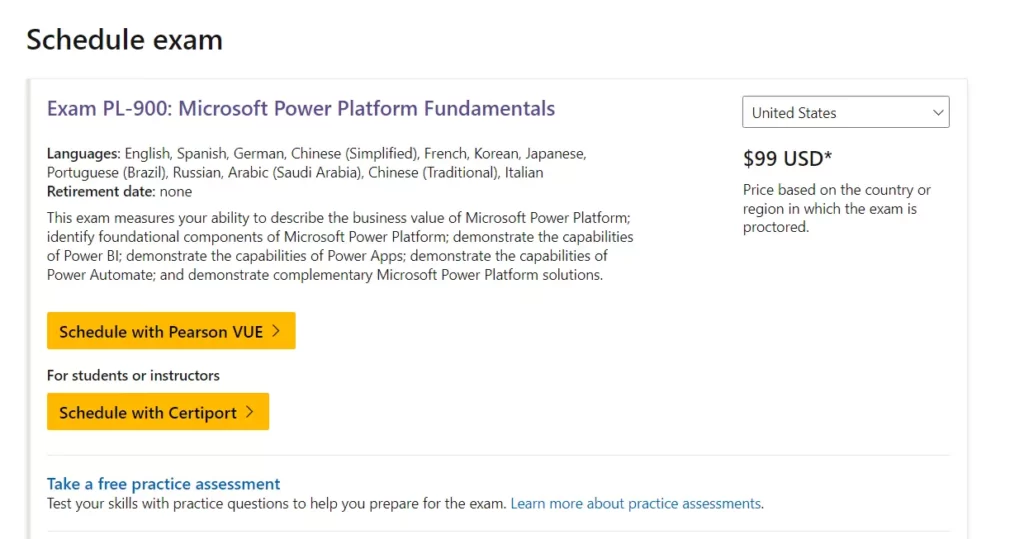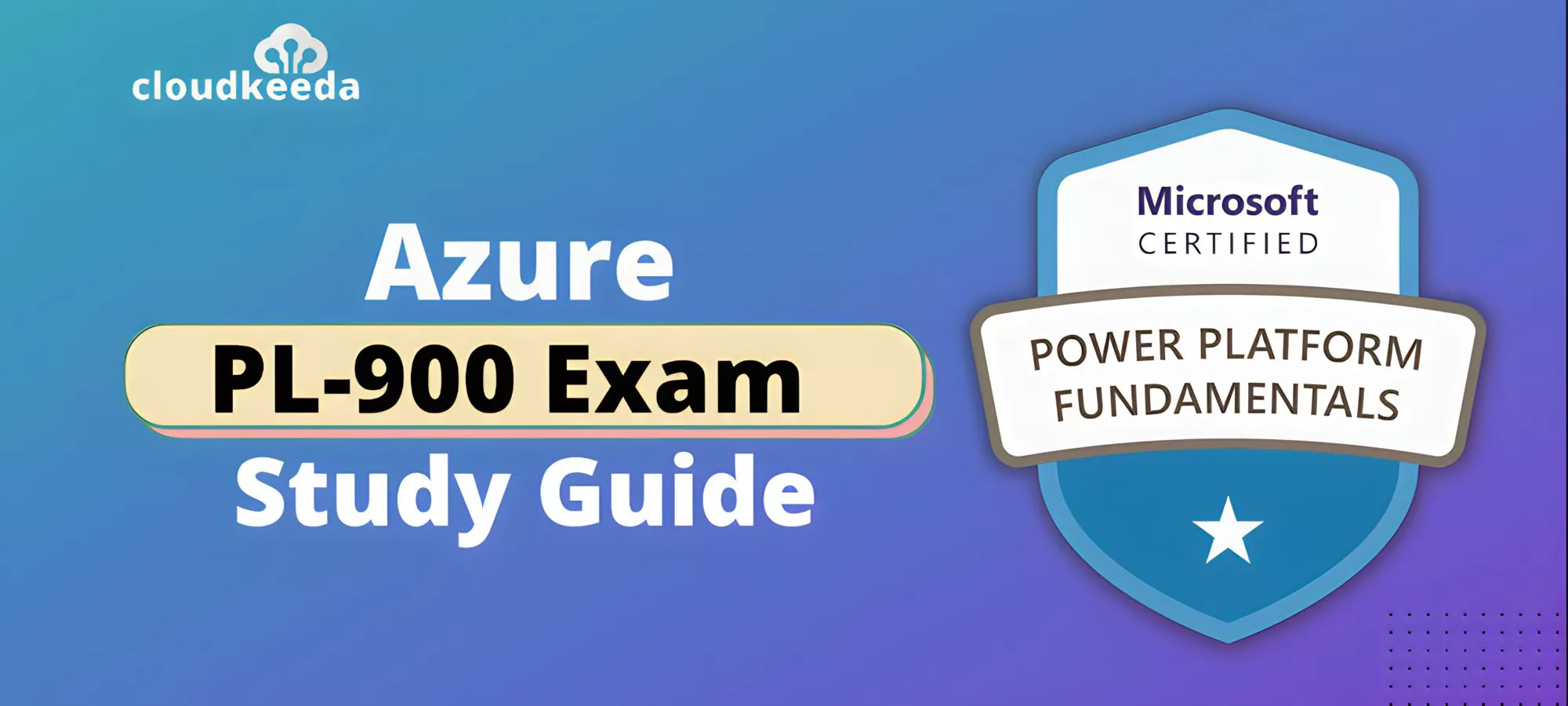A business that wants to streamline its operations cannot do without the Microsoft Power Platform. However, a person must be skilled and knowledgeable in order to benefit from it fully. This is where the PL-900 certification comes into play.
By achieving PL-900 certification, a candidate can demonstrate their understanding of the Power Platform and be able to stand out from the crowd.
In this article, we’re going to examine what the PL-900 certification entails. Here we will discuss its benefits, who should take it, and what you need to know to pass.
So, if you’re a tech lead, customer relationship manager, CRM consultant, or just looking to improve your Power Platform skills, read on.
Table of Contents
PL-900 Certification Overview?
PL-900 Certification measures a candidate’s proficiency in identifying core components, formulating business value, estimating Power Automate capabilities, confirming the value of Power Virtual Agents, and interpreting and illustrating Power Platform’s features.
This Microsoft Power Platform Fundamentals qualifying exam contains 40 to 60 questions. There are various formats for these questions, such as short answers, multiple-choice questions, case studies, drag-and-drop questions, etc. The exam lasts 60 minutes or an hour.
The PL 900 certification is for IT pros who want to increase their skills using Power Automate, Power Platform, etc. Also, those who work in similar fields and are business users, functional consultants, or functional consultants, would benefit significantly from this Microsoft certification.

Are you new to Azure Cloud? Do check out our blog post on the Microsoft Certification Roadmap 2023 and choose the best certification for you.
Ace the PL-900: MS Power Platform Fundamentals exam with flying colors using this proven practice test. Enroll Now and accelerate your path to success!
Why PL-900 Certification?
Today, professionals who are experts in Microsoft Power Platform business operations are in demand due to their niche nature.
Nevertheless, employers need to make sure candidates’ skills are validated. The PL-900 certification helps you to do this as well as allows you to communicate on your behalf as well.
With hands-on experience with all the Power Platform tools, you’ll be a cut above your competition. Aside from that, this certification gives you:
- Competitive edge by automating business processes
- Increase customer engagement and relationships with chatbots
- Valuable insights by creating dashboards
- Make Power Platform work for you
- Make your resume stand out by getting certified in Microsoft
- Track your clients’ preferences and sentiments with the AI builder.
- Pick the right Power Platform tool to identify and implement business and tech acumen.
Also Check: PL-100 Exam Study Guide
Who This Certification Is For?
The Pl-900 certification is for you if you’re looking for:
- To demonstrate your ability by using the Microsoft Power Platform.
- Create frictionless Power Apps
- Use Power BI to simplify data analysis
Then this is the right certification for you.
Furthermore, if you want to become a Microsoft Power Platform Developer, then the PL-900 is essential. This exam will validate your MS Power Platform skills and add some depth to your existing knowledge.
Also, it’s right for technical leads who want to broaden their knowledge of the Microsoft Power Platform. With new tools and solutions, Microsoft keeps updating its services. Thus, it’ll help technical leads update their Power Platform skills.
Lastly, the PL-900 exam is perfect for customer relationship managers and CRM consultants. With Microsoft Power Platforms, businesses have a lot of CRM tools to choose from, which they need CRM solution consultants to help them with.
Also Read: PL-200 Exam Study Guide
Benefits of PL-900 Certification
The PL-900 certification will benefit you in the following ways:
- By learning Power platform basics, you can build a mobile/tab compatible app in a day with little or no coding.
- Provide intelligent solutions to your clients as a certified Power Platform professional.
- With Microsoft Power Automate, you can create flows and automate business processes.
- You can quickly create a dashboard that will impress your clients.
- You can deploy a chatbot on your organization’s website by building one.
- Stay ahead of your competitors by creating attractive portals for your customers.
- You can predict your customer’s sentiment by using AI Builder.
PL-900 Exam Details
Exam Name PL-900: Microsoft Power Platform Fundamentals Exam | Passing Marks 700 |
Exam Fee $99 | Exam Duration 60 Minutes |
Exam Validity Lifetime | Exam Languages English, Spanish, German, Chinese (Simplified), French, Korean, Japanese, Portuguese (Brazil), Russian, Arabic (Saudi Arabia), Chinese (Traditional), Italian |
Total Questions 40-60 Questions | Exam Type Multiple-choice and Multiple response questions |
PL-900 Exam Skills Measured
Describe the business value of Microsoft Power Platform | 20-25% |
Identify foundational components of Microsoft Power Platform | 10-15% |
Demonstrate the capabilities of Power BI | 10-15% |
Demonstrate the capabilities of Power Apps | 20-25% |
Demonstrate the capabilities of Power Automate | 15-20% |
Demonstrate complementary Microsoft Power Platform solutions | 15-20% |
Check Out: Pl-300 Exam Study Guide
How to Register for PL-900 Certification Exam
You can register for the Microsoft Power Platform Fundamentals Exam (PL-900) by going to the Official Microsoft Page.

Prerequisite for PL-900 Certification
A foundational level of knowledge of Power Platform and Microsoft Azure Services is necessary for fresh graduates or candidates with some business application experience such as Dynamics 365.
Also, it is necessary to have a good understanding of cloud computing concepts in order to pass the Microsoft Power Platform Fundamentals PL-900 certification exam.
Also Check: PL-400 Exam Study Guide
PL-900 Exam Study Guide
Describe the business value of Microsoft Power Platform (20–25%)
Describe the business value of Microsoft Power Platform services
- Describe the value of Power Apps to build applications
- Describe the value of Power Automate to automate processes
- Describe the value of Power BI to gain insights into data
- Describe the value of Power Pages to build websites
- Describe the value of Power Virtual Agents to create chatbots
- Describe the value of connectors to integrate services and data
- Describe the value of Microsoft Dataverse to organize business data
- Describe the value of AI Builder to enhance apps and flows
Describe the business value of extending business solutions by using Microsoft Power Platform
- Describe how Microsoft Power Platform apps work together with Microsoft Dynamics 365 apps
- Describe how Microsoft Power Platform business solutions work together with Microsoft 365 apps and services
- Describe how Microsoft Power Platform apps work together
- Describe how Microsoft Power Platform works with Microsoft Teams
- Describe how Microsoft Power Platform business solutions can consume Microsoft Azure services
Describe Microsoft Power Platform administration and governance
- Describe the Microsoft Power Platform security model
- Describe environments
- Describe where to perform specific administrative tasks including Microsoft Power Platform admin center and Microsoft 365 admin center
- Describe how Microsoft Power Platform supports privacy and accessibility guidelines
Identify foundational components of Microsoft Power Platform (10–15%)
Describe Microsoft Dataverse
- Describe differences between traditional databases and Microsoft Dataverse
- Describe tables, columns, and relationships in Microsoft Dataverse
- Describe business logic in Microsoft Dataverse
- Describe dataflows for Microsoft Dataverse
Describe connectors
- Describe the components of a connector
- Describe standard and premium connectors
- Identify use cases for custom connectors
Demonstrate the capabilities of Power BI (10–15%)
Identify basic Power BI components
- Describe Power BI Desktop and Power BI Service
- Compare and contrast dashboards, workspaces, reports, and paginated reports
- Describe how to clean and transform data by using Power Query
- Describe how AI Insights helps identify anomalies and trends in data
Build a basic dashboard by using Power BI
- Create a Power BI report by adding visualizations
- Create a Power BI dashboard
- Add visualizations to dashboards by using Q&A
- Consume Power BI reports and dashboards
Demonstrate the capabilities of Power Apps (20–25%)
Identify basic Power Apps capabilities
- Describe the differences between canvas apps and model-driven apps
- Describe use cases for and capabilities of canvas apps
- Describe use cases for and capabilities of model-driven apps
Build a basic canvas app
- Connect to data sources by using connectors
- Create an app from data
- Add controls to canvas app screens
Build a basic model-driven app
- Create a model-driven app from tables
- Modify forms
- Create and modify views
Demonstrate the capabilities of Power Automate (15–20%)
Identify basic Power Automate components
- Describe use cases for cloud and desktop flows
- Describe use cases for cloud flow templates
- Describe how Power Automate cloud flows use connector triggers and actions
- Describe Power Automate use cases for approvals, Microsoft Teams, Outlook, SharePoint, and Forms
- Describe the Power Automate apps including Power Automate for Desktop, Power Automate mobile, and the Power Automate portal
- Describe actions for Power Automate desktop flows
- Describe document processing in Power Automate
Build a basic Power Automate flow
- Create a cloud flow by using an instant, automated, or scheduled flow template
- Modify a cloud flow
- Add flow steps to perform data operations
- Run a cloud flow
- Build a basic desktop flow by recording tasks
Describe complementary Microsoft Power Platform solutions (15–20%)
Describe the capabilities of Power Virtual Agents
- Describe use cases for Power Virtual Agents
- Describe the purpose of topics, entities, and actions
- Create topics from existing FAQs by using Suggest Topics
Describe the capabilities of Power Pages
- Describe use cases for Power Pages
- Describe use cases for templates
- Describe how to share data externally
Describe the capabilities of AI Builder
- Describe use cases for AI Builder
- Describe the lifecycle to create an AI Builder model
PL-900 Exam Retake Policy
Here is how you can retake the Microsoft Exam PL-900
- Those who are unable to pass the exam on their first try must wait for a minimum of 24 hours before making another attempt.
- A minimum gap of 14 days is necessary for candidates who fail the exam for the second time before attempting it again.
- If someone attempts the exam for the fourth or fifth time, they must also wait for a period of 14 days before attempting it again.
Conclusion
PL-900 certifications are a great way for individuals to validate their skills and differentiate themselves from the crowd. Anyone interested in improving their Power Platform skills, including technical leads, customer relationship managers, CRM consultants, and CRM consultants, will benefit from this certification.
By earning the Microsoft Azure PL-900 certification, one can gain a competitive edge, automate business processes, increase customer engagement, and make their resume stand out.
Overall, PL-900 certifications are definitely worth it with the increasing demand for Microsoft Power Platform professionals. So, think about getting certified with PL-900 if you’re looking to enhance your Power Platform skills.
FAQs
Q1. Is the PL-900 exam hard?
Actually, PL-900 is a relatively easy exam to pass. If you work hard, you can pass the pl-900.
Q2. Is PL-900 worth it?
Yes, PL-900 is worth it because when you study for the PL-900 exam, you’ll learn how to use Power BI, Power Apps, Power Automate, and Power Virtual Agents to create tools for your company.
Q3. How long is PL-900 valid for?
PL-900: Microsoft Power Platform Fundamentals Certification will remain valid for two years.
Q4. How long is the PL-900 exam?
PL-900 exam is 60 minutes long.
Q5. How many questions are on the PL-900 exam?
The PL-900 exam typically consists of 40-60 multiple choice questions.
Q6. What is the passing score for the PL-900 exam?
The passing score for the PL-900 exam is 700 out of 1000.
Q7. How much does it cost to take the PL-900 exam?
The cost of the PL-900 exam may vary by location, but it is typically around $99 USD.

